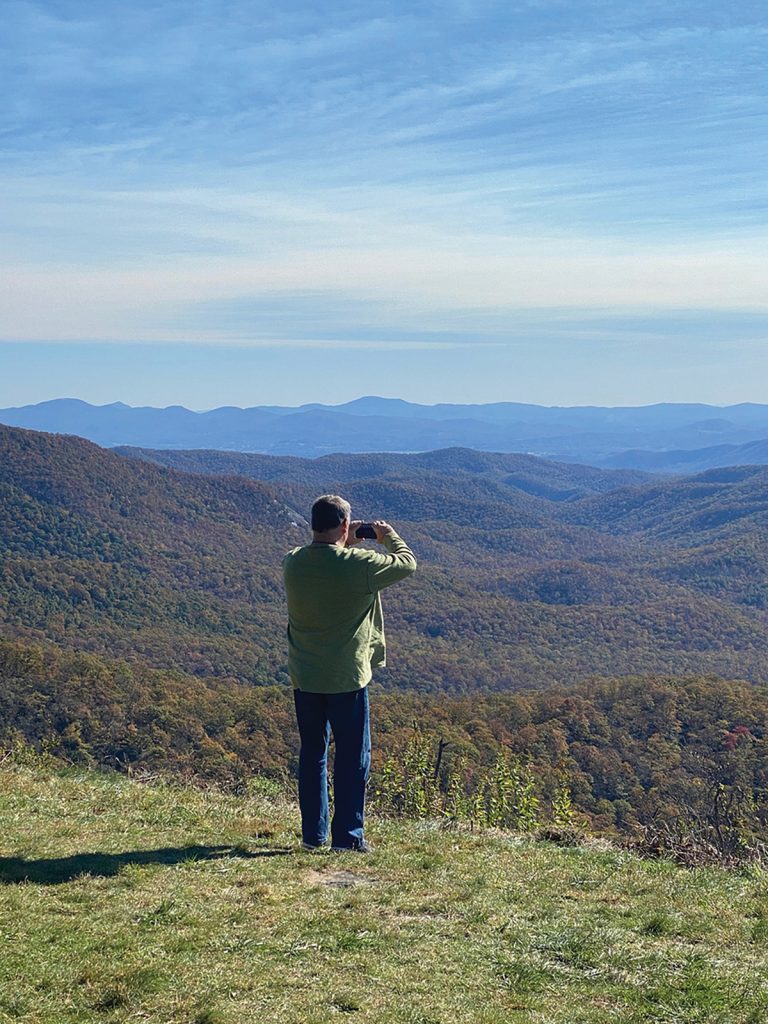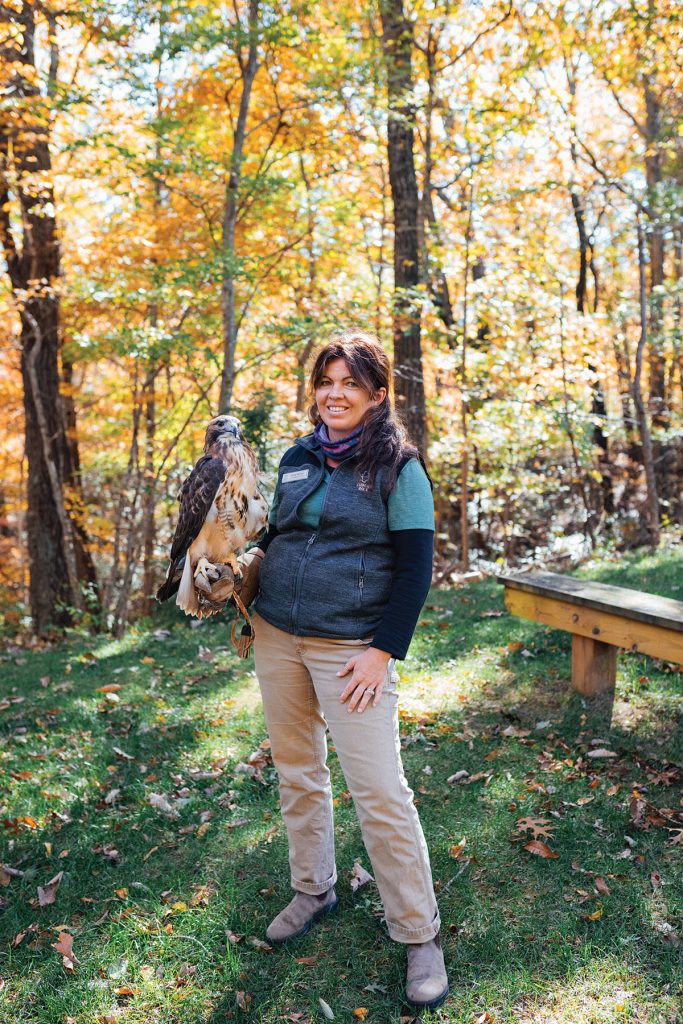
Travis Weil, sponsored by Fox Mountain Guides, will rappel down Chimney Rock in December. Photo by Audrey Goforth
If rappelling 210 feet down Chimney Rock isn’t adventurous enough, try doing it in a Santa suit. “I can’t see much below the belly, and the beard gets in the way,” Travis Weil admits. This will be Weil’s fourth year playing Santa for Chimney Rock’s holiday event.
Weil will rappel down the cliff six or seven times a day for two days. It requires a lot of strength and energy — especially when he takes the stairs back up, instead of the 26-story elevator that runs through the mountain to Chimney Rock’s 315-foot-tall, 535-million-year-old eponymous monolith.
“You can’t understand comfortable until you’ve experienced uncomfortable,” Asheville native and avid rock climber Michael Sulock says. Clinging to a sheer rock 50 feet off the ground is just a typical Sunday afternoon for Sulock, who started rock climbing at 19 when a friend took him to The Climbing Club of Chapel Hill.
“There’s unlimited potential to challenge yourself on a mental and physical level,” says Sulock. He recently scaled the daunting “nose” route up the 3,000-foot El Capitan monolith in Yosemite — and also appeared in the Huffington Post for helping organize a rescue of tourists caught in out-of-control wildfires at the national park.
Karsten Delap, a sponsored athlete and owner of Fox Mountain Guides and Climbing School in Pisgah Forest, which hosts the Santa drop at Chimney Rock, agrees: “It’s like a chess game in your head,” he explains. Asheville resident Greg Pope did his first climb in the summer of 1988, and he’s been hooked ever since. “It’s an adrenaline rush,” he says.
 American Mountain Guides Association single-pitch instructor Jeremy Devine is pictured here on two unnamed ice climbs in Pisgah National Forest. The sport is gaining traction in WNC, where variable weather conditions make it touch-and-go. Photo by Karsten Delap
|
There’s “sport climbing,” which uses bolts or permanent anchors attached to the rock walls. Traditional, or “trad,” is where the protection gear is placed as the climber ascends, whereas “bouldering” involves climbing lower heights without ropes and dropping onto a crash pad. All these safety measures are an integral part of serious climbing. Delap notes: “Statistically, it’s less dangerous than driving a car.”
Location, Location …
Delap took a break from the annual American Mountain Guides Association conference in Boulder, Colorado, to talk to Bold Life. He’s noticed a huge spike in interest in the sport. “Once you have the gear, it’s a way to recreate cheaply, like mountain biking,” Delap explains.
Western North Carolina, with its many destinations including Whiteside Mountain, Looking Glass Rock, Cedar Rock, Big Green Mountain, and Rumbling Bald, coupled with beautiful forests and year-round climbing, has attracted avid climbers for decades.
“The first ascent of the nose of Looking Glass was done in 1966,” notes Delap.
“Looking Glass Rock has routes some people compare to Yosemite’s ‘big walls,’ since they can take several days,” Sulock adds.
Laurel Knob in the Cashiers Valley is among the tallest rock faces on the east coast, with more than 1,000 feet of climbing surface. This prized spot is now owned by the Carolina Climbers Coalition (CCC), who purchased it in 2006 with the help of donations from climbers all over the world. The CCC continues to purchase land to preserve it, and they also maintain trails.
 Asheville native Michael Sulock scaled Yosemite’s infamous peak this summer; he also helped organize a forest-fire rescue. Photo provided by Michael Sulock
|
The Southeastern weather at times even allows for ice climbing, which literally means climbing up a frozen waterfall. Delap says February is the month for the most reliable ice-climbing conditions, usually found along the Blue Ridge Parkway or at Whiteside Mountain in Cashiers. But winter is forecasted early this year, and climbers must prepare for unpredictable mountain weather.
“I went ice climbing one time on the Parkway,” Pope says, “It was five degrees, with the wind blowing 50 miles per hour, and I wasn’t happy.”
Ins and Outs
Another reason more people are getting into the sport is the ability to learn indoors before facing real rock. “There’s been an explosion in indoor climbing gyms,” says Delap, acknowledging ClimbMax in Asheville and the Brevard Rock Gym.
The largest regional gym is Stone Summit in Atlanta, including 25- to 60-feet-tall indoor climbing areas. They’ve just opened a second location in nearby Kennesaw, Georgia.
“The problem is, people build strength [indoors] but not technical know-how,” Delap says. “The ‘Know the Ropes Initiative’ [a program of the American Alpine Club] is educating the gym-taught public about equipment and climbing etiquette.” For instance: “When you’re outside, you put the ropes up yourself.”
Lead climbing is an advanced technique where the person in front places the anchors, taking responsibility for climbers behind. People of all backgrounds and fitness levels are drawn to the sport, but Pope believes the ability to control one’s fear of heights is the thing they all have in common. “I’ve seen many people over the years stop at the 15-foot level and not be able to get beyond it,” he says.
“The difference between climbing and guiding is managing risks,” says Delap. Fox Mountain Guides is the only program in the Southeast accredited by the AMGA; they only hire AMGA-certified instructors and guides.
“I grew up on a farm,” Delap says. “Farm work is hard, but guiding is twice as hard. It’s also twice as fun.”



